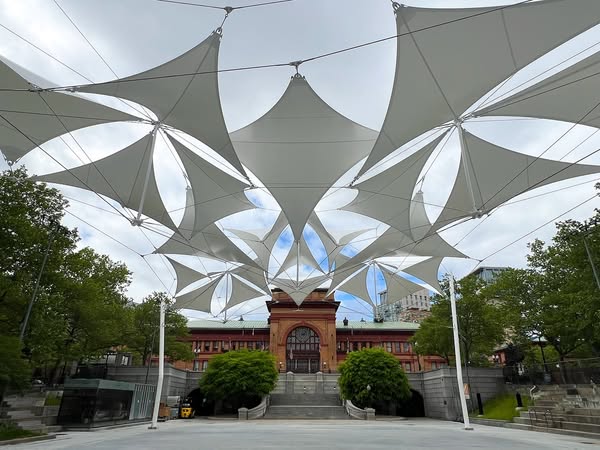Comparing Commercial Fabric Structures Versus Metal Warehouses: Which Wins?

Many business owners must decide which structural system will work best for growing or developing additional storage, warehousing, and operational spaces. Conventional metal warehouses have been used for years, but new kinds are being noticed because they are less costly, can be set up faster, and need less upkeep. The top factors in choosing between traditional and modern construction are how the building performs, its durability, and whether it works well for commercial purposes. This article will discuss what differentiates metal warehouses from Commercial Fabric Structures.
Why the Comparison Matters for Today’s Business Environment
Since materials become more expensive and flexibility is required, businesses prefer structures that provide benefits and stability. Read on to find out what is good and bad about each type to assist you when you decide.
Construction Time and Installation Requirements
For seasonal firms, startups, and fast-scaling companies, getting daily operations going as soon as possible is very important. Constructing metal warehouses takes more time because the foundation must be built, special framing systems are needed, and the welding or bolting is done at the site. Weather conditions, available contractors, and special permits can cause projects to take several months or even a year to complete. On the other hand, Commercial Fabric Structures go up much quicker than conventional structures. Many of their components are designed and shipped in advance, ready to be assembled. It shouldn’t take too long to set up, which means less delay. Cutting down the schedule both cuts costs and prevents business plans from being interrupted.
Cost of Materials and Long-Term Investment
Metal warehouses require steel, stable concrete buildings, and skilled experts, which cost more upfront. The overall budget usually goes up once building permits, engineering layouts, and utility programming are added. Metal warehouses are often viewed as a long-term way to save money, but you must pay more upfront. Fabric buildings are often a cost-effective way to create space. In most cases, steel or aluminum frames are covered in strong, tensioned fabric in Commercial Fabric Structures. As a result, the company spends less on materials and employee wages. Though they only work for a few years, their affordability sees them used by businesses that want to replace parts without big financial costs.
Durability and Weather Resistance
Buildings should be tested on how they react to weather changes, wind, snow, UV rays, and temperature shifts. Metal warehouses perform well when faced with external forces. Regular care can keep corrugated metal rooftops in use for decades through all kinds of weather. Durability is an important focus in the design of many fabric structures. The fabric on commercial structures is frequently coated to block UV, and the system is tensioned to work with any wind loads. Yet, they might not stand up well in locations with a lot of hail or heavy snow unless extra steps are taken. The problem disappears in calm climates or for short-term applications.
Energy Efficiency and Natural Light
For many companies, cutting energy expenses is an important goal. Metal warehouses need artificial lighting and better insulation to control the temperature within the building. As a result, people pay more for energy during the busiest periods for heating or cooling. Fabric-based structures perform particularly well in this situation. Because the windows are clear from the inside, lots of light enters the building, and there is less need for electric lighting. Thanks to reflective coatings, Commercial Fabric Structures tend to be cooler in warm weather, helping save on air conditioning. By doing this, the workspace becomes both sustainable and inexpensive to operate.
Customization and Flexibility
You can customise metal buildings to fit your exact needs, but it usually means paying more and waiting longer. If you decide to use an existing metal building for something else—by inserting windows, adding HVAC, or including additional rooms—you must make major changes to the structure. By nature, Commercial Fabric Structures can easily change shape. Some are designed so that they can be easily upgraded or transported. Because of their open plans, these buildings are a perfect choice for warehouses, sports areas, and storage without pillars. They come in handy when companies prepare for more growth or exchange regular business processes.
Maintenance and Longevity
Many metal warehouses can last more than 40 years if well maintained. However, they may begin to rust or corrode easily in damp or coastal atmospheres. To maintain their condition, it’s important to paint, cover, and inspect your roof often. In general, fabric structures do not need as much maintenance as traditional structures. The covering on the roof is engineered not to allow mold, mildew, or corrosion. Commercial Fabric Structures rarely need a lot of cleaning and tension checking. Although they don’t last as long as metal structures, the costs to keep them in good shape are usually less.
Conclusion
Determining which warehouse is better for your project depends on its purposes, your budget, and the place where it should be built. Although metal is strong and will last a long time, fabric buildings are built quickly, offer many ways to be used, and are often less expensive. Businesses that wish to save energy, use environmentally friendly designs, and have projects completed quickly should carefully consider Commercial Fabric Structures.





